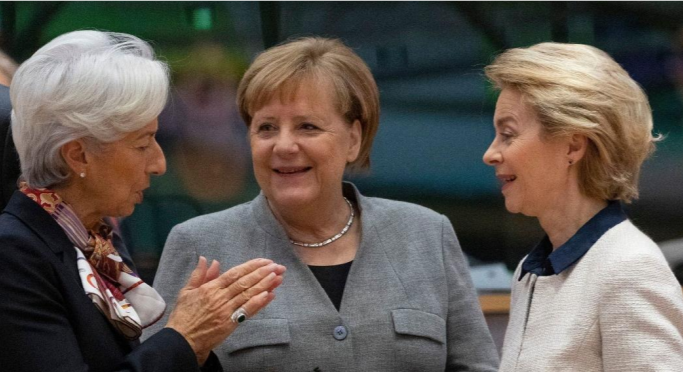EU-landene halter langt efter USA i stimulering af økonomien, og cheføkonomen Erik Nielsen hos italienske UniCredit mener, at EU-landene på næste uges topmøde bør forøge hjælpen dramatisk med 2 pct. af BNP. EU-landene var hurtige med finanspakken sidste sommer, men det er ikke tilstrækkeligt, og USA har øget indsatsen så meget, at der er en økonomisk forskel på 8,5 pct. af BNP mellem Europa og USA, og Europa kommer først på før-krise-niveauet i slutningen af næste år, mens USA kommer på ret køl i år.
As I have argued before, after an impressive 2020 response, the European fiscal approach this year is disappointing:
At an estimated 8.5% of GDP, the eurozone’s output gap was about double the size of the US gap at the beginning of 2021, courtesy of a sizable existing pre-pandemic gap and a deeper hit to GDP last year.
Nevertheless, on present policies by the national fiscal authorities in the eurozone, plus the estimate of the share of the NGEU money likely to be disbursed in the eurozone this year, we in my team estimate that the total discretionary cash fiscal stimulus in 2021 amounts to no more than
3.5% of GDP.
In addition, we estimate the automatic stabilizers to provide another 2.5% of GDP, for a total 6% of GDP in 2021 fiscal stimulus (and this assumes that all the extra-ordinary measures from last year, including the guarantees, will all be rolled forward).
In other words, at a time when every reasonable economist would acknowledge the significant uncertainties with respect to the outlook and the effectiveness of policies, and that going too big is better than going too small, the eurozone is set up to provide only some 70% of the output gap in overall fiscal stimulus.
This means that eurozone GDP is likely to reach its pre-pandemic level only around mid-2022, and that any hope of restoring GDP to the level of previous years’ (already modest) trend line
remains elusive.
I just don’t understand the prevailing “this should be good enough” narrative, which is problematic on so many levels. I sure hope there’ll be some fresh thinking around the table when EU leaders meet again on March 25-26.
Very few people argue for a stimulus package as big as the Biden’s, but let’s at least try to match the output gap – which calls for another 2% of GDP, or so, of discretionary fiscal stimulus! (And yes, if it were all up to me, I would do 3%-4% of GDP extra because of the uncertainties and the benefits of going too big, relative to going to small.)
Also on Thursday, Biden signed into law his promised USD 1.9 trillion fiscal stimulus package. To put this in perspective, this year alone, the US government is now set to provide discretionary fiscal stimulus on a cash basis of about 11% of GDP. In addition, we estimate that automatic stabilizers will provide almost 1% of GDP in further stimulus. All in all, the US economy is looking at an overall cash fiscal stimulus this year of 11%-12% of GDP.
That is three times the estimated output gap at the beginning of the year, a ratio never seen before in an OECD country.
By any economics rationale, this is a case of overkill. But as I have discussed in recent weeks, a lot of uncertainty applies to both the economic outlook and the effectiveness of the support measures, and there is every reason to aim too high rather than too low. The positive effects of a too big package are obvious (faster recovery, job creation and stronger longer term growth because of less risk of scarring), while the negative ones are less obvious (the marginal effect on growth of the stimulus will
likely be smaller so the increase in nominal GDP will not match the increase in public debt).
We all began to revise up our US GDP forecasts. Most importantly, in their excellent March Interim Report “Strengthening the recovery: The need for speed”, out this past week, the OECD revised up its forecast for US 2021 GDP growth to a whopping 6.5%, from the 3.3% estimated in December.
This suggests – on our calculations – that the US economy will not only reach its pre-pandemic GDP level already in Q2 of this year, it will even exceed the extension of its pre-pandemic trend line sometime next year.
While a financial crisis induced recession is a very different animal than a lockdown induced one, it is still worth contrasting this impressive new US outlook with the aftermath of the great financial crisis in 2007. Largely due to the meagre immediate fiscal response to that crisis, and the reversal of fiscal stimulus around 2011 in both the US and Europe, it took seven years – seven! – for OECD per capita GDP just to be restored to its pre-crisis level.
And the extension of the old trend line has never been reached.
On OECD estimates, the US fiscal stimulus is the single biggest contributor to a revision up also of global GDP growth to 5.6% this year, from a previously estimated 4.2%.
Specifically, it helps raise the forecast for the eurozone to 3.9% from 3.6% in December. An old Danish proverb goes like this: “When it rains on the priest, it drips on the parish clerk”. You get the picture.
The OECD’s report is highly recommended in its entirety. It’s here: OECD Economic Outlook > Volume 2020, Supplement 2.
















